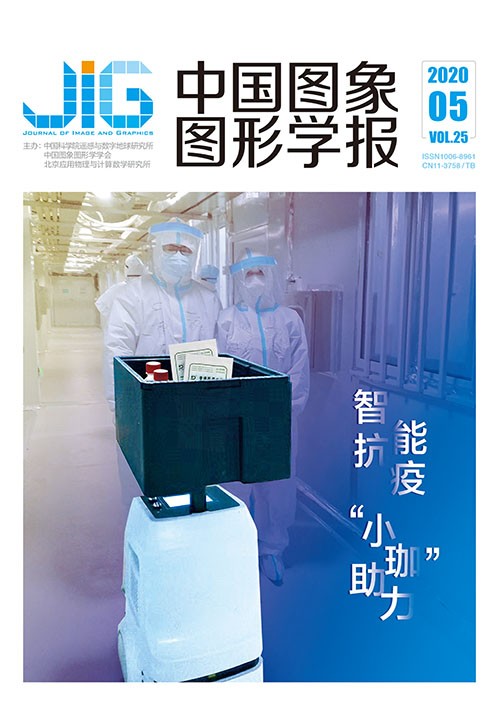
肌骨超声图像特征检测及拼接
颜焕欢1,2, 张培镇1,2, 王伊侬1,2, 李璇3, 阳维1,2, 王青1,2(1.南方医科大学生物医学工程学院, 广州 510515;2.广东省医学图像处理重点实验室南方医科大学, 广州 510515;3.南方医科大学南方医院, 广州 510515) 摘 要
目的 肌骨超声宽景图像易出现解剖结构错位、断裂等现象,其成像算法中的特征检测影响宽景图像的质量,也是超声图像配准、分析等算法的关键步骤,但目前仍未有相关研究明确指出适合提取肌骨超声图像特征点的算法。本文利用结合SIFT (scale invariant feature transform)描述子的FAST(features from accelerated segment test)算法以及SIFT、SURF(speeded-up robust features)、ORB(oriented FAST and rotated binary robust independent elementary features(BRIEF))算法对肌骨超声图像序列进行图像拼接,并对各算法的性能进行比较评估,为肌骨超声图像配准、宽景成像提供可参考的特征检测解决方案。方法 采集5组正常股四头肌的超声图像序列,每组再采样10幅图像。利用经典的图像拼接算法进行肌骨图像的特征检测以及图像拼接。分别利用上述4种算法提取肌骨超声图像的特征点;对特征点进行特征匹配,估算出图像间的形变矩阵;对所有待拼接的图像进行坐标变换以及融合处理,得到拼接全景图,并在特征检测性能、特征匹配性能、图像配准性能以及拼接效果等方面对4种算法进行评估比较。结果 实验结果表明,与SIFT、SURF、ORB算法相比,FAST-SIFT算法所提取的特征点分布更均匀,可以检测到大部分肌纤维的端点,且特征点检测时间最短,约4 ms,其平均匹配对数最多,是其他特征检测算法的25倍,其互信息和归一化互相关系数均值分别为1.016和0.748,均高于其他3种特征检测算法,表明其图像配准精度更高。且FAST-SIFT算法的图像拼接效果更好,没有明显的解剖结构错位、断裂、拼接不连贯等现象。结论 与SIFT、SURF、ORB算法相比,FAST-SIFT算法是更适合提取肌骨超声图像特征点的特征检测算法,在图像配准精度等方面都具有一定的优势。
关键词
Feature detection algorithm of musculoskeletal ultrasound image and its application of image stitching
Yan Huanhuan1,2, Zhang Peizhen1,2, Wang Yinong1,2, Li Xuan3, Yang Wei1,2, Wang Qing1,2(1.School of Biomedical Engineering, Southern Medical University, Guangzhou 510515, China;2.Guangdong Provincial Key Laboratory of Medical Image Processing, Southern Medical University, Guangzhou 510515, China;3.Nanfang Hospital, Southern Medical University, Guangzhou 510515, China) Abstract
Objective Musculoskeletal ultrasound (MSKUS) is an imaging diagnosis method commonly applied in the diagnosis and treatment of musculoskeletal diseases. The feature detection of MSKUS image plays an important role in image registration, image analysis of MSKUS images, and extended field-of-view ultrasound imaging, requiring extraction of the effective feature points. However, the contrast of the ultrasound image is low, and speckle noise and image artifacts are presented in the MSKUS images. These limitations negatively affect the extraction of the feature points of MSKUS image. Consequently, the accuracy of image registration and the quality of image stitching are affected. This condition may lead to misalignment and fracture of anatomical structure on the MSKUS panoramic image. An algorithm suitable for detecting feature points of MSKUS images has not been clearly determined. The objectives of this study are to evaluate the performance of the four local feature detection algorithms on stitching MSKUS sequence images, including scale invariant feature transform (SIFT), speeded-up robust features (SURF), oriented FAST and rotated binary robust independent elementary features(ORB), and features from accelerated segment test (FAST) combined with SIFT descriptor, and to provide a basis and reference solution of feature detection for MSKUS image registration and extended field-of-view ultrasound imaging in future research. Method Ultrasound image sequences of the quadriceps muscles in five normal human subjects are collected. From the image sequence of each subject, 10 images are resampled every five frames for image feature detection and image stitching. The classical image stitching method proposed by Brown is adopted in this study, which includes the following three main steps. First, the feature points of the MSKUS image are extracted by SIFT, SURF, ORB, and FAST-SIFT. Then, based on the obtained feature points and their corresponding feature point descriptors, the nearest neighbor distance ratio method is applied to achieve rough feature matching, and the random sample consensus (RANSAC) algorithm is used to realize fine feature matching. The projection transformation matrix is taken as the basic model to estimate the optimal deformation matrix between the two images. Finally, the deformation matrix between the two images is used to obtain the internal parameters of the camera and the external parameters of the camera. These camera parameters can be used to transform the 10 images into the coordinate system of the reference image. After coordinate transformation, all the 10 images are stitched together. Then, the MSKUS panorama is post-processed using the maximum flow minimum cut algorithm to find the unwell-stitched overlapped area. The multiband fusion is used to reduce the artificial and rough seam zones. The MSKUS panorama is eventually obtained. To evaluate the performance of the four algorithms SIFT, SURF, ORB algorithms, and FAST-SIFT, detection of feature points, feature matching, image registration, and image stitching are assessed. Result The experimental results show that compared with SIFT, SURF, and ORB algorithms, FAST-SIFT is able to extract more uniform distribution feature points and detect most of the end points of the muscle fibers. Furthermore, the detection time of feature points by using FAST-SIFT is much shorter of approximately 4 ms.The average number of matching points in FAST-SIFT is the largest, which is 2~5 times as many as other feature detection algorithms. FAST-SIFT algorithm has the highest correct rate of feature matching. The mean value of mutual information and normalized cross-correlation coefficient of FAST-SIFT are 1.016 and 0.748, respectively, which are higher than that of the other three feature detection algorithms. Result indicates high accuracy of image registration. Moreover, the stitched panorama of MSKUS by using the FAST-SIFT algorithm shows good image stitching, that is, no obvious misalignment and fracture of anatomical structure are found. Conclusion Compared with SIFT, SURF, and ORB, FAST-SIFT algorithm is more suitable to extract the feature points of MSKUS image. It has advantages in the distribution of feature points, the detection time of feature points, the average number of matching points, the correct rate of feature matching, image registration accuracy, and image stitching result.
Keywords
musculoskeletal ultrasound image feature detection feature matching image registration image stitching
|



 中国图象图形学报 │ 京ICP备05080539号-4 │ 本系统由
中国图象图形学报 │ 京ICP备05080539号-4 │ 本系统由